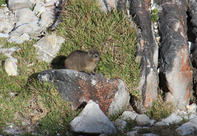Diet and Grooming
Dassies have a unique intestinal tract amongst mammals. Beyond the stomach is a large sack that contains the bacteria for the fermentative digestion of cellulose. This joins onto the caecum (where bacterial fermentation usually takes place in simple-gut mammals) via a short extension of intestine.

The caecum possesses two horn-shaped processes, a design usually found in birds. The caecum is involved in manufacturing fatty acids that serve as an additional source of energy to the energy-conservative hyrax.
Dassies are equipped with sharp incisor teeth, one large pair on the upper jaw and two pairs on the lower. These teeth are modified for use as defence weapons. They have triangular tips, which are sharpened by articulation against the opposite pair. These are especially well developed in the males, the upper pair overlaying the bottom lip and being visible when his mouth is closed.
The incisors are sometimes used to strip the bark off trees during spring when the inner bark is rich in moisture and nutrients being transported to the leaves. Usually, however, the majority of the dassie’s food is cropped with its cheek teeth which develop a sharp outer edge through wear and tear. There is a relatively large space between the incisors (there are no other front teeth) and the row of cheek teeth.
This arrangement is similar to a rhino’s teeth. Dassies groom themselves with a specialized grooming claw present on the inner digit of both hind feet. They may also use their lower incisors for this function. Grooming is done regularly to rid themselves of external parasites and dassies will engage in grooming after a bout of sunning.
The heat of the sun probably makes the parasites move around making it easier to find and remove them. They may take dust baths to help with parasite removal too.
By Megan Emmett